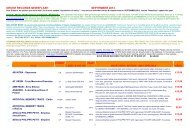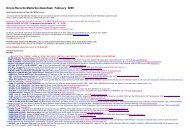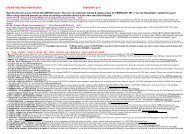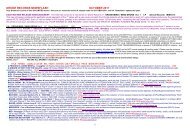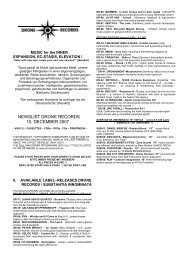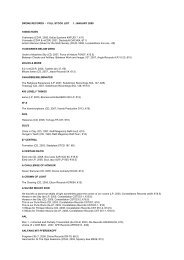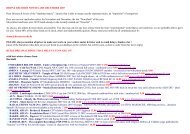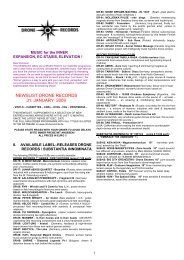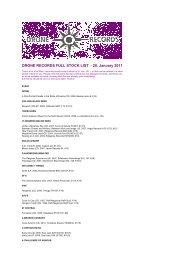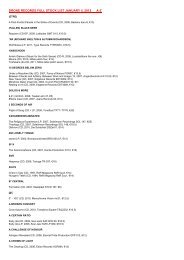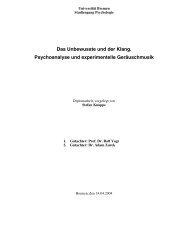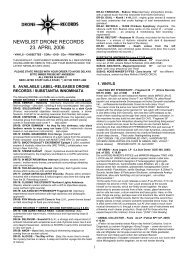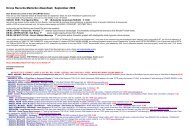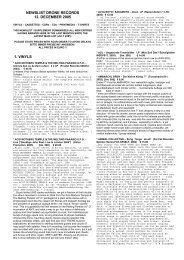CODES: - Drone Records
CODES: - Drone Records
CODES: - Drone Records
Create successful ePaper yourself
Turn your PDF publications into a flip-book with our unique Google optimized e-Paper software.
than not remains subtle experiments in avant drone and abstract<br />
sound." - Aquarius <strong>Records</strong><br />
"This is easily some of the most evocative proto-drone work to reach<br />
these ears in a while, with beautiful almost folk melodies that flutter on<br />
the edge of audibility cut up with a thick soup of early-evening smog<br />
and long forgotten geographies. Somewhere between early Flying<br />
Saucer Attack, Mirror and William Basinski. Highly recommended." -<br />
David Keenan, Volcanic Tongue<br />
"If Windy & Carl's vision of Antarctica is your idea of bliss, you will drool<br />
over this soundscape depiction of Peter Wright's home in New Zealand.<br />
Now living in London, these are what the label calls "love-drones," as<br />
Wright's memories of his home's wide open spaces inspire slowly<br />
unfolding waves of lush guitar." - Jim Steed, Fakejazz “ [label info]<br />
XENAKIS, IANNIS – Electronic Music CD (Electronic Music<br />
Foundation EMFCD003, 1997) € 13.00<br />
BACK IN STOCK!!<br />
„Wichtige Aufnahmen aus dem Werk, v.a. der Frühzeit des griechischen<br />
Komponisten: 4 der hier enthaltenden Stücke entstanden 1957-1962 im<br />
INA GRM-Studio in Paris bei PIERRE SCHAEFFER. Ein weiteres<br />
stammt aus dem Jahre 1970 (nur instrumentale Sounds), das letzte<br />
schließlich ist unter Einsatz eines speziellen Computer-Programmes<br />
entstanden, welches XENAKIS entwickelt hat (1992). Schön &<br />
erstaunlich die geräuschhaft-dröhnig-elektronischen Stücke aus seiner<br />
Anfangszeit...“ [old <strong>Drone</strong> <strong>Records</strong> info]<br />
“Superlative and long desired reissue of Xenakis's early electronic<br />
works, including the in-demand pieces from his his pioneering<br />
Nonesuch album Electro-Acoustic Music. Issued in collaboration with<br />
France's INA-GRM, the studio where the first 3 of these compositions<br />
were realized. Although it only makes up a tiny portion of his total<br />
composed work to date, Xenakis's tape works are as legendary and<br />
significant as those of Schaeffer, Henry or Stockhausen. Powerful, mind<br />
expanding listening -- this release certainly will rate as one of 1997's<br />
most important experimental musical documents. Includes the following<br />
works: "Diamorphoses" (1957): "a study of white noise and its<br />
graduations through the process of densification." "Concret PH" (1958):<br />
"This very short work is a sound continuum without a single break.<br />
Xenakis pre-recorded crackling embers from which he extracted very<br />
brief (one-second) sound elements. Then he assembled them in huge<br />
quantities, varying their density each time. This work can be compared<br />
to his instrumental preoccupations concerning 'clouds of sound'."<br />
"Orient-Occident" (1960): "one of the major masterpieces for<br />
tape...conceived as a music for a film by Enrico Rulchignoni." "Bohor"<br />
(1962): "dedicated to Pierre Schaeffer...an extraordinary and deafening<br />
sound continuum where the listener is invited, in a figurative sense, to<br />
hear bells chime while standing inside them!" "Hibiki-Hana-Ma" (1970:"<br />
"Xenakis recorded and reworked sequences played by an orchestra, a<br />
biwa, and a snare drum but never rendered them unrecognizable.<br />
Distributed over 12 tracks, the work's sonorities were elaborated in<br />
function of a highly pronounced spatialization. The title of this piece<br />
means 'reverberation -- flower -- interval." "S.709" (1992) recorded with<br />
the GENDYN program: "Both the sounds produced in the piece as well<br />
as the global evolution of the composition are literally unheard of:<br />
despite the abstract nature of the processes involved and their<br />
mechanical nature, the Xenakis sound world is immediately<br />
recognizable." [press release]<br />
* ZGA – Zgamoniums CD (ReR Megacorp ReR ZGACD, 1991)<br />
€ 14.00<br />
“.... Musik, die in ihrer Originalität schwer zu beschreiben ist: Industrial-<br />
Noise-Rock-Improvisationen zwischen AMM, EINSTÜRZENDE<br />
NEUBAUTEN, DDAA (nur um eine vage Klangwelt anzudeuten).<br />
Harsche Rhythmen, knirschendes, schrillendes Metall, monotoner<br />
Sprechgesang, gequälte Trash-Elektronik – invalide Cyberpunks<br />
wühlen als Schamanen der Zukunft im postatomaren Schrott –<br />
Lähmung, Statik, gegen die ein archaischer Beat ostinat antrommelt...“<br />
[Rigobert Dittmann in Bad Alchemy Nr. 14 zur ersten ZGA-LP (1990)]<br />
“New works from the extraordinary Rigan Quartet; sound bites from<br />
'real' and electrified scrapyard instruments; an indescribable and<br />
incomparable group who have succeeded both in defying genre and<br />
creating radically new sounds.” [ReR]<br />
„ZGA pflegen die Perkussion auf eisernen Objekten, wie es so manche<br />
Band in den 80er Jahren tat. Aber anders als diese entfachen sie kein<br />
Industrialdonnerwetter, sondern loten mit kratzender oder streichender<br />
Behandlung die eher leisen Gefilde bzw. atmosphärischen<br />
Möglichkeiten des Materials aus. Die senkrecht aufgehängten Spiralen,<br />
Eisenplättchen und -stangen bilden zudem das Herzstück für Stücke,<br />
die einen entfernten Rockkontext lediglich in dekonstruierter Form<br />
erahnen lassen. Plötzliche Brüche im Aufbau geben den Stücke einen<br />
rohen und fragmentarischen Charakter. Wenn mit einem plötzlichen<br />
Schwenk die Geräuschkulisse kippt und eine verquerte Klarinette<br />
Volksweisen anstimmt, wirkt das nicht als beliebige Geste. In die<br />
Aufnahmesession, die die Band erstmals in ein professionelles Studio<br />
führte, haben ZGA ihr Erfahrung im Umgang mit nicht vorhandenem<br />
Equipment, will sagen die Bastlermentalität des Improvisateurs im<br />
Gegenständlichen nochmals mit herüber genommen. Immerhin<br />
fuhrwerkeln ZGA seit 1984, noch hinter dem eisernen Vorhang und<br />
unter erschwerten Bedingungen, an ihrer Musik herum und da steckt<br />
nun mal auch immer der geniale Schuss Punk drin, der die Dinge so<br />
erscheinen läßt wie wir sie mitunter gar nicht gern sehen: ständig<br />
reparaturbedürftig. _ZGA are working on iron objects like some of the<br />
industrial bands from the 80ties. But in spite of them, they are more in<br />
the quietly fields sounding out the materials possibilities with scratching<br />
and stringing. Coil springs and/ or iron plates played with iron bars are<br />
the heart for pieces far away from any rock context. Sudden breaks are<br />
disturbing the structures giving them a rough and fragmentary<br />
character. When in a sudden move the sound scenes are changing and<br />
a strange clarinette starts playing in terms readily comprehensible to the<br />
layman, it is not only any gesture they like. Since 1984 they have been<br />
existing as a band working behind the iron curtain. Maybe for that<br />
reason they developed an improvising talent in dealing with heavy<br />
circumstances especially for musicians like them. Now for this session<br />
ZGA have worked the first time in a professional studio and they used<br />
their brilliant punk spirit which makes that the things seem to be in a<br />
way we do not always like to see them: currently under construction.”<br />
[Mr. Schlewinski for <strong>Drone</strong> <strong>Records</strong>]<br />
4.1. CD COMPS<br />
* A FIELD GUIDE TO TABLE OF THE ELEMENTS do-CD (Table of<br />
the Elements TOE-CD-90, 2006) € 22.00<br />
Schön aufgemachte Label-Compilation des ambitionierten US-Verlags<br />
inklusive einiger unveröffentlichter Tracks….<br />
"Since 1993, Table of the Elements has spoken that truth, focusing on<br />
musicians whose light shimmers outside the frames of convention and<br />
registering the ripples of music that are too essential to die or dissolve<br />
into the common currency. It has prospected for the rarest sort of sonic<br />
lode, the uncut goods blessed with a hearty half-life. The label's 100plus<br />
releases are a vital contemporary archive, a survey of meaningful<br />
eruptions across a broad horizon of improvised, experimental, minimal<br />
and outsider musics. Here, on these two CDs, is a field guide to the<br />
essential Table of the Elements. This sampler is more than a summary<br />
of label highlights; the performances make a statement as bold as their<br />
visceral impact and as rich as the conceptual process that underpins<br />
their creation. It's the kind of music Table of the Elements is all about. It<br />
thrives outside the barricades, where no one else is looking. Where the<br />
truth is spoken." Artists featured are: Jonathan Kane, Arnold Dreyblatt,<br />
Zeena Parkins, San Agustin, Tony Conrad, Tony Conrad w/ Faust,<br />
Rhys Chatham, Leif Inge. Disc one has some previously released<br />
material -- (plus tracks by Dreyblatt, Parkins and Conrad that appear to<br />
be previously unreleased). Disc 2 is an unreleased excerpt from Leif<br />
Inge' "9 Beet Stretch" -- Ludwig van Beethoven's 9th symphony<br />
stretched to 24 hours, with no pitch distortions (complete DVD version<br />
on TOE forthcoming!).” [label info]<br />
* ANTHOLOGY OF NOISE & ELECTRONIC MUSIC VOLUME 4 do-<br />
CD & booklet (Sub Rosa SR250, 2006) € 18.00<br />
Der vierte Teil der ANTHOLOGY-Serie, wieder eine bunte Mischung<br />
aus Klassikern, rarem Material und Newcomern, umfassend<br />
dokumentiert. Die Verbindung von “seriöser” Komposition und<br />
experimentellem “Underground”, nirgendwo ist sie so präsent wie in<br />
dieser SUB ROSA-Reihe....<br />
„Each compilation in this excellent series so far has proved an essential<br />
primer, and this fourth offering shows no signs of letting up on either<br />
substance or quality. The compilation begins with something rather<br />
special indeed, and for someone like me who is pretty obsessed with<br />
electronic music history – it’s about as indispensable as it gets. The<br />
track is by Egyptian artist Halim el-Dabh (don’t worry, I haven’t heard of<br />
him either) and was discovered by the Sub Rosa gang hidden in a<br />
French magazine article. Of course as you’ve probably guessed there’s<br />
a good story attatched to this, and the track was actually made in 1944<br />
and subsequently broadcast on Egyptian national radio. Yes, it’s a<br />
piece of abstract pre-musique concrete which was broadcast on prime<br />
time national radio; what must the locals have thought? That’s not all<br />
either, this pre-dates most of what we regard as the ‘first’ electronic<br />
concrete experimentations… so why did nobody know about this? As<br />
the extenseive book so lovingly provided by Sub Rosa reads ‘Pay<br />
tribute to the unknowns, those who work in the shadows...’; never a<br />
truer word spoken. As with all of these compilations, the list of artists is<br />
endlessly exciting and this time we’re treated to exclusive tracks from<br />
Rune Grammofon’s Maja Ratkje, Lauri Spiegel and the psyche-tastic<br />
Vibracathedral Orchestra with rarities coming from Steve Reich, Alvin<br />
Lucier, Ligeti, Robert Wyatt, Oliver Messiaen and Jean Claude Risset<br />
among many more. I don’t think I need to go on about how utterly



